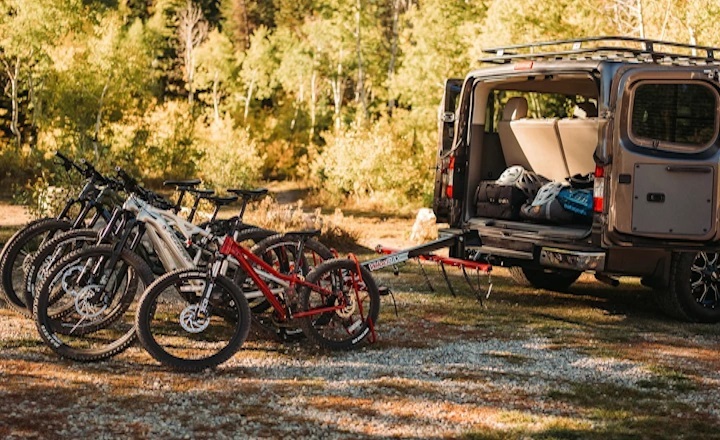
In the past five years, e-bikes and cargo bikes have transformed the way Australian businesses think about delivery. From boutique florists in Melbourne to independent cafés in Brisbane, more small enterprises are swapping petrol-powered scooters and vans for nimble, eco-friendly bikes. The shift isn’t just about reducing costs—it’s about speed, sustainability, and meeting customer expectations in an increasingly competitive market.
But as more SMEs embrace bikes for last-mile delivery, one logistical question keeps cropping up: how do you transport those bikes themselves when they’re off the road? Whether it’s moving them to a service hub, switching locations for an event, or simply transporting extra bikes for busy periods, small businesses need safe and reliable ways to carry their two-wheeled workhorses. That’s where secure bike rack solutions come in.
The Rise of E-Bike Deliveries in Australia
Australian cities are witnessing a sharp increase in businesses using bikes for deliveries. According to recent reports, food and retail deliveries using e-bikes have grown significantly in Sydney and Melbourne, supported by council initiatives to improve cycling infrastructure and reduce congestion. The trend is no longer confined to big delivery apps; smaller operators are embracing bikes as part of their everyday operations.
Courier services, florists, caterers, and even local grocers are finding that bikes provide an efficient way to cover short distances quickly while avoiding traffic. This trend is expected to accelerate as fuel costs rise and consumers demand more sustainable options. ABC News has highlighted this growth in several metro areas, underscoring the business opportunity at play.
Why Bike Transport Still Matters for SMEs
While bikes are excellent for short-distance deliveries, small businesses still face situations where they need to transport multiple bikes by vehicle. Common scenarios include:
- Fleet redeployment: Moving delivery bikes from one store or hub to another.
- Seasonal surges: Adding more bikes for peak events like Valentine’s Day for florists or Christmas for caterers.
- Servicing and repairs: Transporting multiple bikes to a service centre at once.
- Events and marketing: Businesses using branded bikes for pop-up promotions or mobile stalls.
In each of these cases, having a reliable method of securely carrying bikes becomes essential. Without it, businesses risk delays, potential damage to their equipment, and higher operating costs.
The Pitfalls of Improvised Solutions
Many businesses start by improvising—tying bikes down in vans, wedging them in utes, or using old-style boot racks. While this might work in the short term, it often creates bigger problems:
- Damage to bikes: Scratched frames, bent wheels, and compromised battery mounts.
- Safety risks: Loose tie-downs can create hazards for drivers and other road users.
- Time inefficiency: Loading and unloading becomes a slow, frustrating process.
In a business where time is money, and equipment downtime can affect revenue, cutting corners on bike transport quickly proves costly.
Why Purpose-Built Bike Racks Make Sense
This is where purpose-built solutions come into their own. Reliable hitch bike racks can help businesses secure multiple delivery bikes on vans when off the road, reducing handling risk and saving time. Unlike improvised methods, these racks are engineered to handle the weight and size of modern e-bikes, while allowing for quick roll-in, roll-out loading.
For small businesses, the benefits are clear:
- Professional image: Customers notice when bikes and equipment are handled with care.
- Efficiency gains: Faster loading means more deliveries completed each day.
- Longevity of assets: Protecting expensive bikes from damage extends their lifespan.
Practical Tips for Aussie Businesses Considering Bike Racks
If you’re running a small business and considering bike racks for your fleet, here are a few practical factors to keep in mind:
1. Capacity needs: Count how many bikes you’ll typically transport. Racks are available in different capacities—from smaller options for two bikes to larger systems for five or more.
2. E-bike compatibility: Make sure the rack can handle the weight of electric models, which can be significantly heavier than standard bikes.
3. Ease of loading: Look for racks with assisted-lowering or roll-in features to reduce physical strain on staff.
4. Vehicle fit: Confirm that your rack is compatible with your existing vehicle fleet, whether utes, vans, or SUVs.
5. Future-proofing: Choose a system that can scale with your business growth—what works for two bikes today may need to handle six next year.
Beyond Logistics: The Bigger Business Case
Bike racks might seem like a small operational detail, but for SMEs looking to scale, they can represent a crucial investment in efficiency and professionalism. As more Australian consumers expect fast, sustainable delivery, businesses that embrace cycling not only reduce costs but also strengthen their brand reputation.
Moreover, with councils and governments investing in better cycleways and encouraging sustainable transport, SMEs that invest now are likely to gain an early mover advantage. Initiatives like local council grants for sustainable business practices make the business case even stronger. Business.gov.au offers guidance on sustainability programs that can apply to SMEs across Australia.
The Bottom Line
Delivery by bike is no longer just a quirky trend—it’s becoming part of the fabric of small business in Australia. From couriers and cafés to florists and retailers, SMEs are discovering that bikes make good business sense. But to fully unlock their potential, businesses must think beyond the ride itself and consider the logistics of transporting their fleets.Secure, purpose-built bike racks provide a professional, efficient, and safe way to keep bikes moving when they’re not on the road. For small businesses looking to stay competitive in an evolving market, this simple piece of equipment can be the missing link between sustainability and scalability.
| < Prev | Next > |
|---|




